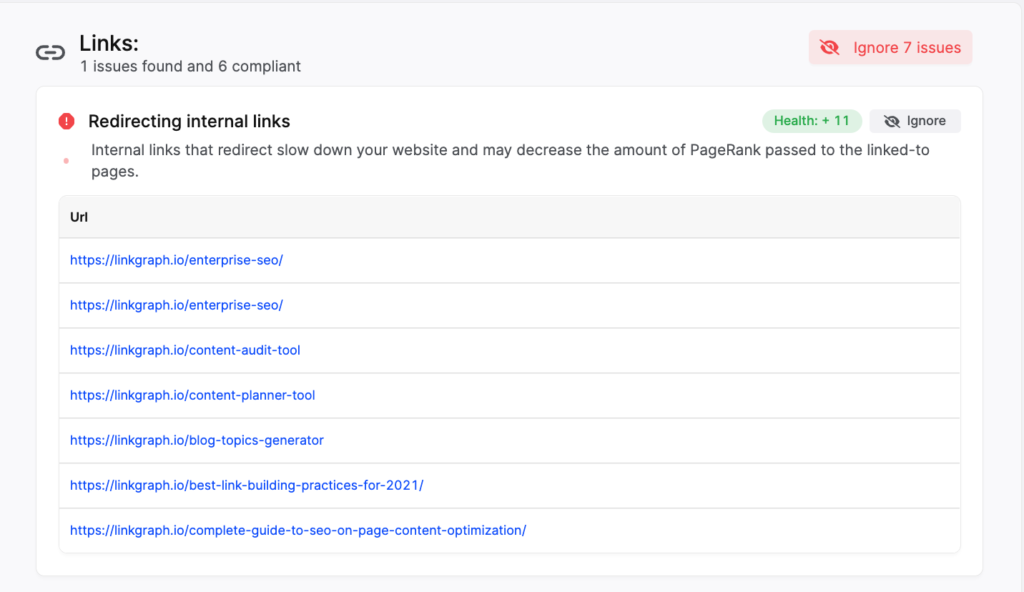301 Redirects for SEO & Common Redirect Issues
Learning how to properly use 301 redirects for SEO can make it so your website maintains keyword rankings and organic traffic even as you make changes to […]
Learning how to properly use 301 redirects for SEO can make it so your website maintains keyword rankings and organic traffic even as you make changes to your content or site architecture.
The reality is, our websites are constantly changing. Good and attentive webmasters will add new and updated content over time to make sure they are providing the highest quality content and page experience to users.
As a result, redirects become necessary to make sure users and search engine crawlers can find your content. But improper use of redirects can result in lost keyword rankings, lost link equity, and a poor user experience for your website visitors.
When implemented with SEO best practices, 301 redirects shouldn’t undermine your SEO efforts, but ensure that your search visibility is maintained. Here’s a guide to 301 redirects and how to implement them correctly.
Types of Redirects
Here are all of the redirects that you might want to know about, particularly if they are mentioned in your Search Atlas site auditor report.
- 301 = “Moved Permanently” – best for SEO
- 302 = “Moved Temporarily” – often used during website redesigns
- Meta Refresh = page-level redirect that is not recommend for SEO
As a general rule, if a page is important and you want it to rank, then you should use a 301 redirect if it the page is ever moved
What is a 301 Redirect?
301 redirects are used to tell browsers and search engines that a web page has been permanently moved to a new location.
For example, https://www.linkgraph.com/why-anchor-text-diversity-is-good-for-your-backlink-profile redirects to https://www.linkgraph.com/anchor-text-diversity
301 redirects ensure that users and search engines are always directed to the most current and relevant content. A 301 redirect tells the search engine that the page has been moved, and the old page can be safely removed from the search engine’s index, while the new page should be indexed instead.
Why Do 301 Redirects Matter for SEO?
There are a few ways that 301 redirects can impact your web pages SEO performance.
- Ensure your most up-to-date versions of your web pages are what are indexed and shown to searchers
- Protects site visibility of your web pages during and after site migrations
- Helps you maintain the majority of the link equity the original page has earned through backlinks or previous link building efforts
Here is a video from Google Search Central about how link equity is passed through a redirect.
Common Redirect Issues
There are some common issues that occur with redirects that can impact SEO performance. It’s possible that one or more of these issues will be flagged if you run an SEO audit using the Site Auditor in your Search Atlas dashboard.
Broken Redirects
Broken redirects are those that point to 404 or dead pages. When this happens, you will often see an error message like this:
The negative impact of a broken page for users and search engines is pretty clear, so you want to avoid sending either to a dead page at all costs.
Unfortunately, broken redirects are hard to detect without the use of a site auditor. But if you’re a webmaster for an ecommerce website with thousands of product pages that are constantly being added or old pages being deleted, broken redirects are more common than you might think.
Here are the two ways you can resolve this issue.
- Reinstate the dead page so the redirect is no longer broken
- If you want the dead page to stay dead, you need to remove every internal link on your website that points to that dead page
Redirect Chains & Redirect Loops
Although when used sparingly, redirects are good for SEO, then can also. harm your SEO performance if used excessively.
A redirect chain occurs whenever one or more redirects point from a url to a destination url.
Google does not want to see redirect chains on your website, as they slow down your website and make it take longer for Google to crawl your website.
Redirect loops are when your redirects point to urls with other redirects, sending spiders in a loop where they never arrive at a destination page at all.
As a general rule, it should never take more than one redirect to get to a destination page.
The best way to avoid excessive redirect chains is to make sure you use SEO friendly urls from the beginning. That means optimizing your urls from the and sticking to them after you update the content.
However if you do need to resolve a redirect chain or loop, take the following steps.
- For redirect chains: Replace the redirect chain with a single redirect
- For redirect loops: Fix the final destination url
Redirecting to HTTP instead of HTTPS
It’s important that HTTP pages always redirect to HTTPS protocols. HTTPS provides users with a safer browsing experience and it is a confirmed ranking factor.
For more info on getting an SSL certificate and redirecting an HTTP site to HTTPs, read our detailed guide on HTTPS.
Internal Links with Redirects
If you have internal links that redirect, it is likely slowing down your website and causing you valuable link equity.
The site audit report will let you know if this issue is present on any of your pages.
After adding a new version of a page or deleting a page, a part of your regular website maintenance needs to be updating all of your internal links that previously pointed to those pages to the new destination url.
This can take some time, particularly if you have a lot of web pages and are using internal links to elevate your SEO performance.
But it shows Google that you’re an active webmaster that is doing the necessary work to make your website the best place for visitors.
Redirects in XML Sitemaps
There should be no pages in your XML sitemap that redirect to other destination urls. You should be updating your sitemap instead with the new destination so Google crawlers are directed straight to the newest version of the page that you want indexed.
Other Redirect Errors
There are a few other redirect issues that might be flagged in your Site Audit report.
Redirect urls should be lowercase.
And all of the protocol variants (HTTPS, HTTPS) should redirect to the same destination url.
How to Setup a 301 Redirect
There are many ways to implement a redirect depending on your content management system. Some CMS like WordPress will automatically set up a 301 redirect when you make changes to the url path of an existing page.
There are also many plugins that you can add to your WP site that help confirm on-page SEO best practices with redirects.
But to add a redirect manually, you will need to edit your .htaccess file.
A .htaccess is a powerful website file that is used by Apache web servers. It is located in the root directory of your website. The root directory may be in a folder labeled public_html, www, htdocs, or httpdocs, depending on your hosting provider.
To edit the file, all you need is the old page’s URL and the new page’s URL.
- Log in to your website’s hosting account.
- Find the file that contains your website’s code.
- Look for the code that redirects users to a specific page.
- Copy the old page’s URL and paste it into the code, replacing the old URL.
- Copy the new page’s URL and paste it into the code, replacing the old URL.
- Save the file and upload it to your website’s server.
- Test the redirect by visiting the old page’s URL. You should be redirected to the new page.
Conclusion
If you have a large website and you haven’t been thinking about redirects until recently, there may be quite a bit of technical work you need to do to get your site on track.
Not sure whether you have redirect issues on your website? Run a free site audit.
If you are unable to resolve the redirect issues identified in your SIte Audit report on your own, reach out to our technical SEO team.
We can do the work of optimizing your linking profile so you meet Google’s standards, speed up your website, and create a better experience for your website visitors. In addition, enhance your overall digital presence with our tailored White Label PPC Services, perfect for boosting your site’s traffic and visibility.























































































